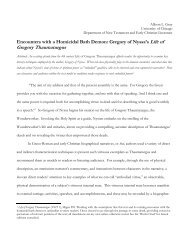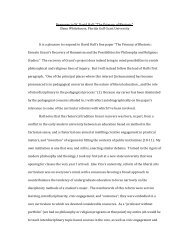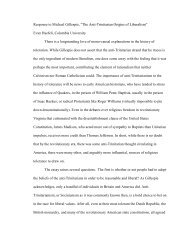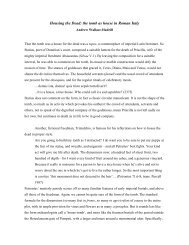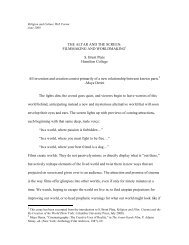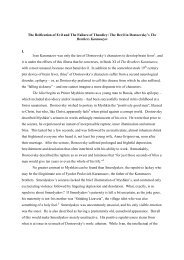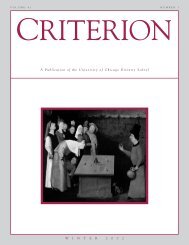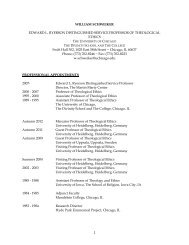Nota Bene - University of Chicago
Nota Bene - University of Chicago
Nota Bene - University of Chicago
You also want an ePaper? Increase the reach of your titles
YUMPU automatically turns print PDFs into web optimized ePapers that Google loves.
epitaph, seeking to extract the marrow <strong>of</strong> facts about Christianity in the late second century<br />
from it. 11 But whatever it was, in its original context (and, as this paper seeks to emphasize, it<br />
has had many recontextualizations!) the epitaph <strong>of</strong> Abercius was part <strong>of</strong> a complex and grand<br />
monument that was more than words, and more than message -- it was also the tomb, the<br />
repository <strong>of</strong> the body <strong>of</strong> the man who speaks in first person in the epitaph he say he wrote<br />
while alive, not just to tell <strong>of</strong> his trip to Rome, but also to guarantee the inviolability <strong>of</strong> the buried<br />
body which the stone marks. My purpose in this essay is to give expression to some <strong>of</strong> my<br />
attempts to ask about and fill in the blankness <strong>of</strong> my own iconographic imagination in multiple<br />
ways, as informed by our encounter with Roman and Christian burials in Rome and Tunisia last<br />
summer.<br />
The historical Abercius pursued a journey from his Asian homeland to Rome, and after<br />
his return to Asia Minor composed for himself a tomb monument so impressive that it was<br />
talked about centuries later, and was incorporated into legend in the fourth or fifth century vita<br />
Abercii, 12 from which it found its way into the Menologia (from the anonymous compiler, and<br />
also Simeon Metaphrastes) and Acta Sanctorum traditions. 13 The tradition-historical<br />
relationship between the literary life and the documentary inscription have been the subject <strong>of</strong><br />
lively debate, largely because the reconstruction <strong>of</strong> the epigram depends upon a critical<br />
assessment and cautious alignment <strong>of</strong> these traditions and recensions, together with the<br />
Alexander inscription. 14 In order to contextualize the Abercius inscription, we shall first look at<br />
how the ancient literary traditions have done so, and how they wish us to view the object before<br />
us.<br />
Page 4<br />
According to legend Abercius lived in Hieropolis <strong>of</strong> Phrygia Salutaris. Written much in<br />
------------------------------------<br />
11<br />
This is replicated in scholarship continually, in which the inscription is interpreted as though simply a<br />
given text (in such a standard resource as H. Strathmann and Th. Klauser, “Aberkios,” RAC 1 [1950] 12-17).<br />
12<br />
ed. Th. Nissen, S. Abercii Vita (Leipzig: Teubner, 1912); hereafter cited by chapter number, with Nissen’s<br />
page in parentheses. In terms <strong>of</strong> dating, the work mentions �Ιουλιανο� ς ο� παραβα� της in §66 [47], hence it post-dates<br />
361-363. J.B. Lightfoot (Apostolic Fathers, part II, vol. 1 [London: Macmillan, 1889] 500) puts it at ca. 380 CE.<br />
13<br />
ed. G. Lüdtke and Th. Nissen, Teubner, 1910.<br />
14<br />
There has also been debate about whether this Abercius is the same as the Averkios Marcellus<br />
mentioned by Eusebius in HE 5.16.3 as the person to whom Apolinarius dedicated a treatise against the Montanists.<br />
The inscription does not appear to have any anti-Montanist elements, in my judgment.




